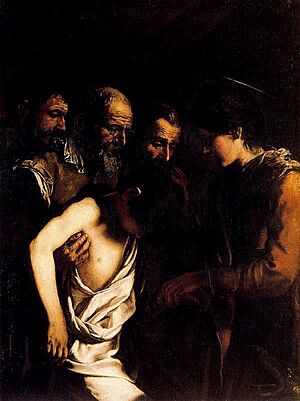Giovanni Serodine facts for kids
Giovanni Serodine (born 1600 – died December 21, 1630) was a talented painter from Switzerland and Italy. He lived during the early Baroque period, a time known for dramatic and emotional art.
Who Was Giovanni Serodine?
Giovanni Serodine was born in Ascona, a town now in Switzerland. His family worked with stucco, which is a type of plaster used for decorating buildings. When Giovanni was young, he moved to Rome, Italy. There, he became a painter and developed his own unique style.
His Unique Painting Style
Serodine's art was inspired by the famous painter Caravaggio. This style is called Caravaggisti. It often uses strong contrasts between light and shadow. This technique is known as tenebrism. Serodine's paintings are full of emotion and drama.
His brushstrokes were loose and lively. His paintings also had a special brightness, similar to artists like Johann Liss and Bernardo Strozzi. These artists were active in Venice. Some of Serodine's works, like Coronation of the Virgin in Ascona, show a unique, almost quirky, style.
Giovanni's Famous Works
Even though Giovanni Serodine had a short career, he created many powerful paintings. Here are some of his well-known works:
- Jesus among the Masters (now in the Louvre museum)
- Jesus and the Tribute money (found in the National Gallery of Scotland)
- Saint Lawrence distributing alms (originally for a church, now in Sermoneta)
- Decapitation of Saint John the Baptist (also for a church in Rome)
- Saint Michael (once in a church called San Pietro in Montorio)
- Road to Emmaus and Sons of Zebedee (both in Ascona)
- Portrait of his father (in Lugano)
- Portrait of a Philosopher (in Rancate)
A writer named Giovanni Baglione admired Serodine's art. He noted how lively and full of energy his paintings were. Sadly, Serodine did not make many friends or find many art supporters in Rome. He died at a young age, leaving behind a small but impressive collection of art.
See also
 In Spanish: Giovanni Serodine para niños
In Spanish: Giovanni Serodine para niños


